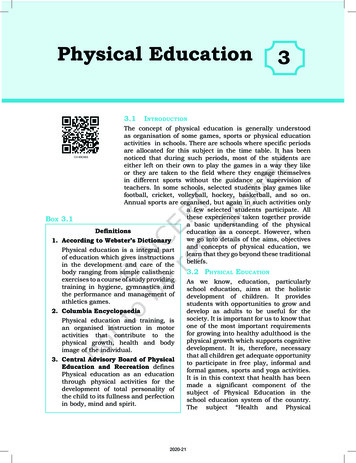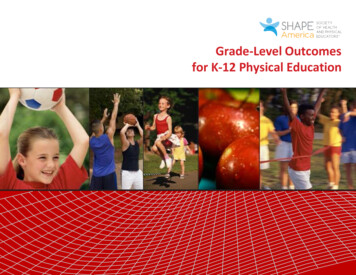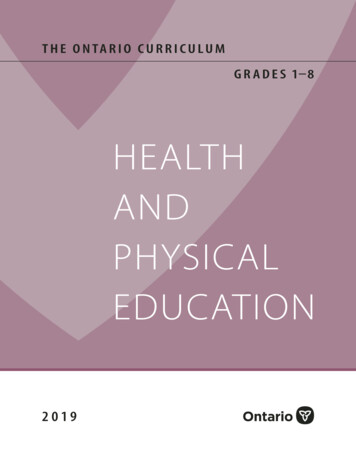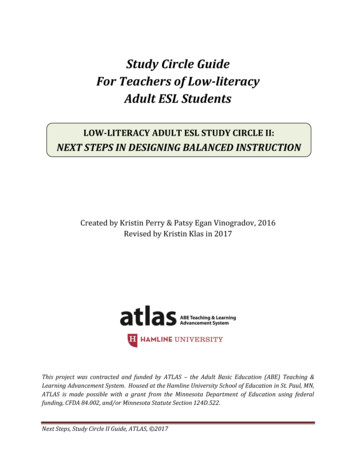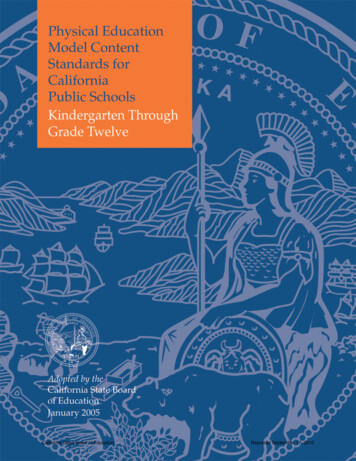
Transcription
California Department of EducationReposted September 17, 2010
Physical EducationModel Content Standardsfor CaliforniaPublic SchoolsKindergarten ThroughGrade TwelveCalifornia Department of EducationReposted September 17, 2010
Publishing InformationWhen the Physical Education Model Content Standards for California Public Schools, KindergartenThrough Grade Twelve was adopted by the California State Board of Education on January 12, 2005,the members of the State Board were the following: Ruth Green, President; Glee Johnson, Vice President; Ruth Bloom, Don Fisher, Ricky Gill, Reed Hastings, Joe Nuñez, Bonnie Reiss, Suzanne Tacheny,and Johnathan Williams.This publication was edited by Sheila Bruton and Faye Ong, working in cooperation with DianneWilson-Graham, Consultant, Professional Development and Curriculum Support Division. It was prepared for printing by the staff of CDE Press: the cover and interior design were created and prepared byPaul Lee; typesetting was done by Jeannette Reyes. It was published by the Department, 1430 N Street,Sacramento, CA 95814-5901, and was distributed under the provisions of the Library Distribution Actand Government Code Section 11096. 2006 by the California Department of EducationAll rights reservedISBN 978-0-8011-1605-6AcknowledgmentsThe following educators were appointed by Jack O’Connell, State Superintendent of Public Instruction,to assist in the development of the Physical Education Model Content Standards under the provisions ofEducation Code Section 60605.2:Scott Bowman, Rancho San Joaquin Middle School, Irvine Unified School District, IrvineJanice Collins, Los Angeles Unified School District, Los AngelesMargaret Elliot, California State University, FullertonJennifer Fry, Meadows Elementary School, Conejo Valley Unified School District, Thousand OaksMilissa Glen-Lambert, Monlux Elementary School, Los Angeles Unified School District, Valley GlenHolly Gunterman, Idyllwild Elementary School, Hemet Unified School District, IdyllwildArleen Hammerschmidt, Oceanside Unified School District, OceansideHasan Hanks, McClatchy High School, Sacramento City Unified School District, SacramentoAsh Hayes, Full Life Fitness, San MarcosNancy Hennefer, Lodi Unified School District, LodiWendy Jones, Marsh Elementary School, Antioch Unified School District, AntiochKaren Mendon, Montebello Intermediate School, Montebello Unified School District, MontebelloBill Monti, Retired Physical Educator, KentfieldMike Mostajo, Nipomo High School, Lucia Mar Unified School District, NipomoDebra Patterson, California State University, NorthridgeGloria Siech, Retired Physical Educator, Mill ValleyBill Silva, Casa Grande High School, Petaluma Joint Union High School District, PetalumaPerky Vetter, California State Polytechnic University, PomonaSusan Wilkinson, San Jose State University, San JoseOrdering InformationCopies of this publication are available for 12.50 each, plus shipping and handling charges. Californiaresidents are charged sales tax. Orders may be sent to the California Department of Education, CDEPress, Sales Office, 1430 N Street, Suite 3207, Sacramento, CA 95814-5901; FAX (916) 323-0823.See page 68 for complete information on payment, including credit card purchases, and an order blank.Prices on all publications are subject to change.A partial list of other educational resources available from the Department appears on page 67. In addition, an illustrated Educational ResourResourcesces Catalog describing publications, videos, and other instructional media available from the Department can be obtained without charge by writing to the addressgiven above or by calling the Sales Office at (916) 445-1260.NoticeThe guidance in Physical Education Model Content Standards for California Public Schools, Kindergarten Through Grade Twelve is not binding on local educational agencies or other entities. Except forthe statutes, regulations, and court decisions that are referenced herein, the document is exemplary, andcompliance with it is not mandatory. (See Education Code Section 33308.5.)California Department of EducationPrepared for publicationby CSEA members.Reposted September 17, 2010
ContentsA Message from the State Board of Education and the State Superintendentof Public Instruction . vIntroduction . viElementary SchoolKindergarten .1Grade One .5Grade Two .9Grade Three .13Grade Four .17Grade Five.21Middle SchoolGrade Six .25Grade Seven.28Grade Eight.31High School .35High School Course 1 .36High School Course 2 .39High School Course 3A: Adventure/Outdoor Activities .42High School Course 3B: Aerobic Activities . 44High School Course 3C: Individual and Dual Activities .46High School Course 3D: Dance .48High School Course 3E: Aquatic Activities .50High School Course 3F: Weight Training and Fitness .52High School Course 4A: Advanced Adventure/Outdoor Activities .54High School Course 4B: Advanced Aerobic Activities .55High School Course 4C: Advanced Individual and Dual Activities .57High School Course 4D: Advanced Dance .59Glossary .61iiiCalifornia Department of EducationReposted September 17, 2010
A Message fromfrom the State Board of Education andthe State SuperintendentSuperintendent of Public InstructionPhysical education significantly contributesto students’ well-being; therefore, it is an instructional priority for California schools andan integral part of our students’ educationalexperience. High-quality physical education instruction contributes to good health,develops fundamental and advanced motorskills, improves students’ self-confidence, andprovides opportunities for increased levels ofphysical fitness that are associated with highacademic achievement. The Physical EducationModel Content Standards for California PublicSchools, Kindergarten Through Grade Twelveaffirms the standing of physical education;rigor is essential to achievement, and participation is not the same as education.Mastering fundamental movement skillsat an early age establishes a foundation thatfacilitates further motor skill acquisitionand gives students increased capacity for alifetime of successful and enjoyable physicalactivity experiences. Similarly, the patterns ofphysical activity acquired during childhoodand adolescence are likely to be maintainedthroughout one’’s life span, providing physical, mental, and social benefits.These standards focus on the content ofphysical education and incorporate the detailrequired to guide the development of consistent, high-quality physical education instructional programs aimed at student learningand achievement. The standards provide acomprehensive vision of what students needto know and be able to do at each grade level.In addition, the standards provide a modelfor high school course design.Standards-based education maintainsCalifornia’’s tradition of respect for local control of schools. To help students achieve athigh levels, local educators—with the fullsupport and cooperation of families, businesses, and community partners—are encouraged to apply these standards and design thespecific curricular and instructional strategiesthat best deliver the content to their students.The physical education model content standards are complete and focused. They represent our commitment to promoting excellencein physical education instruction for everystudent in California.G J President, State Board of EducationJ O’C State Superintendent of Public InstructionvCalifornia Department of EducationReposted September 17, 2010
IntroductionAccording to the U.S. Surgeon General,regular physical activity is one of the most important ways to maintain and improve one’s’sphysical health, mental health, and overallwell-being.1 A student who participates inphysical education is more likely to becomea healthy adult who is motivated to remainhealthy and physically active throughout hisor her life.The physical education model contentstandards represent the essential skills andknowledge that all students need to maintaina physically active, healthy lifestyle. Californialaw clearly establishes the priority of physicaleducation instruction. Education Code Section51210 requires 200 minutes of physical education every ten school days for students ingrades one through six. Education Code Section51222 provides for 400 minutes of physicaleducation every ten school days for studentsin grades seven through twelve.The model content standards provide guidance for developing physical education programs by identifying what each student inCalifornia should know and be able to do ateach grade level. With adequate instructionand sustained effort, students in every schoolshould be able to achieve the standards. Somestudents with special needs may require appropriate accommodations, adaptations, andmodifications to meet the standards. Decisionsabout how best to teach the standards are left1Physical Activity and Health: A Report of the Surgeon General.Atlanta, Ga.: U.S. Department of Health and Human Services,Centers for Disease Control and Prevention, National Centerfor Chronic Disease Prevention and Health Promotion, 1996.to teachers, schools, and local educationalagencies.The forthcoming revision of the PhysicalEducation Framework for California PublicSchools will be based on and incorporate themodel content standards. The framework willprovide guidance for instruction, program development, and support for the teacher. Usedtogether, the standards and framework willserve as a resource for all school stakeholdersin developing a quality physical educationprogram.An Essential DisciplinePhysical education is an integral part of theeducation program for all students. It teachesstudents how their bodies move and how toperform a variety of physical activities. Students learn the health-related benefits of regular physical activity and the skills to adopt aphysically active, healthy lifestyle. The discipline also provides learning experiences thatmeet the developmental needs of students.With high-quality physical education instruction, students become confident, independent,self-controlled, and resilient; develop positive social skills; set and strive for personal,achievable goals; learn to assume leadership;cooperate with others; accept responsibilityfor their own behavior; and, ultimately, improve their academic performance.The model content standards provide opportunities for teachers to reinforce studentlearning in all areas of the curriculum. Thestandards link the content in physical education with content in English–language arts,viCalifornia Department of EducationReposted September 17, 2010
I science, mathematics, and history–socialscience, thereby establishing and emphasizingthe many connections between the subjects.Development of the StandardsThe California Physical Education ModelContent Standards Development Committeewas convened to answer the question, Whatshould California students know and be ableto do in physical education? The physical education model content standards build on thework of exemplary documents and currentresearch on the health-related issues facingchildren and youths in the state.The model content standards also reflectguidance and suggestions from members ofthe California teaching community and othercitizens who attended professional meetingsand public hearings held around the state.At the meetings and hearings, parents andguardians, teachers, administrators, and business and community leaders helped definekey issues. Current practice and the state ofphysical education instruction in Californiawere given special consideration during theprocess. In addition, physical education experts from around the nation reviewed thefirst draft and submitted formal comments.Their ideas helped immeasurably to strengthen the rigor and quality of the standards.Although the committee recognizes thatchanges in practices by schools, teachers,and students will take time, the committeebelieves achieving these standards is a highpriority for California students. The PhysicalEducation Model Content Standards will assistschools in establishing learning goals andobjectives for physical education. A sequential, developmentally appropriate curriculumshould be designed and implemented to helpstudents acquire the knowledge, skills, attitudes, and confidence needed to adopt andmaintain a physically active, healthy lifestyle.Highlights of the StandardsThe five overarching model content standards for elementary and middle school students are as follows:Standard 1: Students demonstrate the motorskills and movement patternsneeded to perform a variety ofphysical activities.Standard 2: Students demonstrate knowledge of movement concepts,principles, and strategies thatapply to the learning and performance of physical activities.Standard 3: Students assess and maintain alevel of physical fitness to improve health and performance.Standard 4: Students demonstrate knowledge of physical fitness concepts,principles, and strategies to improve health and performance.Standard 5: Students demonstrate and utilizeknowledge of psychological andsociological concepts, principles,and strategies that apply to thelearning and performance ofphysical activity.In elementary school the content standardsemphasize the way in which students movethrough space and time in their environment,the way in which the student and a partnermove in space together, the continuity andchange in movement, the manipulation of objects in time and through space, and the manipulation of objects with accuracy and speed.In middle school the content standardsemphasize working cooperatively to achievea common goal, meeting challenges, makingdecisions, and working as a team to solveproblems.viiCalifornia Department of EducationReposted September 17, 2010
I For high school youths the three overarching content standards are as follows:Standard 1: Students demonstrate knowledge of and competency in motor skills, movement patterns,and strategies needed to performa variety of physical activities.Standard 2: Students achieve a level of physical fitness for health and performance while demonstratingknowledge of fitness concepts,principles, and strategies.Standard 3: Students demonstrate knowledge of psychological and sociological concepts, principles, andstrategies that apply to the learning and performance of physicalactivity.The high school experience represents theculmination of physical education. From kindergarten through fifth grade, the content isdelivered incrementally to best enable studentlearning at the appropriate developmentallevel. In sixth through eighth grade, the content is consolidated and students’ skills arerefined, representing a natural progressionof skill sophistication. When students reachninth grade, they are ready to integrate allthat they know with all that they can do. Theybecome capable of higher-order thinking andof more skilled performance. Therefore, thefive elementary and middle school modelcontent standards have been combined intothe three high school model content standardsnoted earlier.To fulfill the requirement for high schoolgraduation, students must take two yearsof physical education in high school. In thispublication these two years are referred to asHigh School Course 1 and Course 2. The content of these courses has been selected fromactivities listed in the California Code of Regulations, Title 5, Section 10060.In addition, High School Courses 3 and 4are electives available to students. All schoolsare required by Education Code Section 51222to provide physical education elective coursesfor students after they have completed theyears of physical education required for graduation.High School Course 3 electives allow students to explore a variety of physical activitiesin search of one for lifelong enjoyment. HighSchool Course 4 electives are designed as acontinuation of High School Course 3 andare intended for students who wish to pursue advanced knowledge and skills and whowant an intensive experience in an activitythat they might commit to for the rest of theirlives.viiiCalifornia Department of EducationReposted September 17, 2010
KindergartenSTANDARD1Students demonstrate the motor skills and movement patterns neededto perform a variety of physical activities.Movement Concepts1.1Travel within a large group, without bumping into others or falling, while usinglocomotor skills.1.2Travel forward and sideways while changing direction quickly in response to asignal.1.3Demonstrate contrasts between slow and fast speeds while using locomotor skills.1.4Create shapes at high, medium, and low levels by using hands, arms, torso, feet, and legs ina variety of combinations.Body Management1.5Create shapes by using nonlocomotor movements.1.6Balance on one, two, three, four, and five body parts.1.7Balance while walking forward and sideways on a narrow, elevated surface.1.8Demonstrate the relationship of under, over, behind, next to, through, right, left, up, down,forward, backward, and in front of by using the body and an object.Locomotor Movement1.9Perform a continuous log roll.1.10Travel in straight, curved, and zigzag pathways.1.11Jump over a stationary rope several times in succession, using forward-and-back andside-to-side movement patterns.Manipulative Skills1.12Strike a stationary ball or balloon with the hands, arms, and feet.1.13Toss a ball to oneself, using the underhand throw pattern, and catch it before it bouncestwice.1.14Kick a stationary object, using a simple kicking pattern.1.15Bounce a ball continuously, using two hands.1California Department of EducationReposted September 17, 2010
KINDERGARTENRhythmic Skills1.16Perform locomotor and nonlocomotor movements to a steady beat.1.17Clap in time to a simple, rhythmic beat.STANDARD2Students demonstrate knowledge of movement concepts, principles,and strategies that apply to the learning and performance of physicalactivities.Movement Concepts2.1Explain the difference between under and over, behind and in front of, next to andthrough, up and down, forward and backward, and sideways.2.2Identify and independently use personal space, general space, and boundaries and discusswhy they are important.Body Management2.3Identify and describe parts of the body: the head, shoulders, neck, back, chest, waist, hips,arms, elbows, wrists, hands, fingers, legs, knees, ankles, feet, and toes.2.4Explain base of support.Locomotor Movement2.5Identify the locomotor skills of walk, jog, run, hop, jump, slide, and gallop.Manipulative Skills2.6Explain the role of the eyes when striking objects with the hands, arms, and feet.2.7Identify the point of contact for kicking a ball in a straight line.2.8Describe the position of the fingers in the follow-through phase of bouncing a ballcontinuously.STANDARD3Students assess and maintain a level of physical fitness to improvehealth and performance.Fitness Concepts3.1Participate in physical activities that are enjoyable and challenging.Aerobic Capacity3.2Participate three to four days each week in moderate to vigorous physical activities thatincrease breathing and heart rate.2California Department of EducationReposted September 17, 2010
KINDERGARTENMuscular Strength/Endurance3.3Hang from overhead bars for increasing periods of time.3.4Climb a ladder, jungle gym, or apparatus.Flexibility3.5Stretch shoulders, legs, arms, and back without bouncing.Body Composition3.6Sustain continuous movement for increasing periods of time while participating inmoderate to vigorous physical activity.Assessment3.7Identify indicators of increased capacity to participate in vigorous physical activity.STANDARD4Students demonstrate knowledge of physical fitness concepts,principles, and strategies to improve health and performance.Fitness Concepts4.1Identify physical activities that are enjoyable and challenging.4.2Describe the role of water as an essential nutrient for the body.4.3Explain that nutritious food provides energy for physical activity.Aerobic Capacity4.4Identify the location of the heart and explain that it is a muscle.4.5Explain that physical activity increases the heart rate.4.6Identify the location of the lungs and explain the role of the lungs in the collection ofoxygen.Muscular Strength/Endurance4.7Explain that strong muscles help the body to climb, hang, push, and pull.4.8Describe the role of muscles in moving the bones.Flexibility4.9Identify the body part involved when stretching.Body Composition4.10Explain that the body is composed of bones, organs, fat, and other tissues.3California Department of EducationReposted September 17, 2010
KINDERGARTENSTANDARD5Students demonstrate and utilize knowledge of psychological andsociological concepts, principles, and strategies that apply to thelearning and performance of physical activity.Self-Responsibility5.1Identify the feelings that result from participation in physical activity.5.2Participate willingly in physical activities.Social Interaction5.3Demonstrate the characteristics of sharing in a physical activity.5.4Describe how positive social interaction can make physical activity with others more fun.Group Dynamics5.5Participate as a leader and a follower during physical activities.4California Department of EducationReposted September 17, 2010
Grade OneSTANDARD1Students demonstrate the motor skills and movement patterns neededto perform a variety of physical activities.Movement Concepts1.1Demonstrate an awareness of personal space, general space, and boundaries while movingin different directions and at high, medium, and low levels in space.1.2Travel over, under, in front of, behind, and through objects and over, under, in front of,and behind partners, using locomotor skills.1.3Change speeds in response to tempos, rhythms, and signals while traveling in straight,curved, and zigzag pathways, using the following locomotor movements: walking,running, leaping, hopping, jumping, galloping, sliding, and skipping.1.4Change direction from forward and back and right and left in response to tempos,rhythms, and signals while walking, running, hopping, and jumping (i.e., locomotor skills).1.5Demonstrate the difference between slow and fast, heavy and light, and hard and softwhile moving.Body Management1.6Balance oneself, demonstrating momentary stillness, in symmetrical and asymmetricalshapes using body parts other than both feet as a base of support.Locomotor Movement1.7Roll smoothly in a forward direction, without stopping or hesitating, emphasizing arounded form.1.8Land on both feet after taking off on one foot and on both feet.1.9Jump a swinging rope held by others.Manipulative Skills1.10Demonstrate the underhand movement (throw) pattern.1.11Demonstrate the overhand movement (throw) pattern.1.12Demonstrate the two-handed overhead (throw) pattern.1.13Catch, showing proper form, a gently thrown ball.1.14Catch a self-tossed ball.5California Department of EducationReposted September 17, 2010
GRADE ONE1.15Catch a self-bounced ball.1.16Kick a rolled ball from a stationary position.1.17Kick a stationary ball, using a smooth, continuous running approach.1.18Strike a balloon upward continuously, using arms, hands, and feet.1.19Strike a balloon upward continuously, using a large, short-handled paddle.1.20Dribble a ball in a forward direction, using the inside of the foot.1.21Dribble a ball continuously with one hand.Rhythmic Skills1.22Create or imitate movement in response to rhythms and music.STANDARD2Students demonstrate knowledge of movement concepts, principles,and strategies that apply to the learning and performance of physicalactivities.Movement Concepts2.1Identify the right and left sides of the body and movement from right to left and left toright.2.2Identify people/objects that are within personal space and within boundaries.Body Management2.3Identify the base of support of balanced objects.Locomotor Movement2.4Distinguish between a jog and a run, a hop and a jump, and a gallop and a slide andexplain the key differences and similarities in those movements.Manipulative Skills2.5Identify examples of underhand and overhand movement patterns.2.6Explain that in the underhand throw, the position of the fingers at the moment of releasecan influence the direction a tossed object and a thrown object travel.2.7Explain that the nonthrowing arm and hand provide balance and can influence thedirection a tossed object and a thrown object travel.2.8Explain that the point of release influences the direction of a tossed object and of a thrownobject.2.9Describe the proper hand and finger position for catching a ball.2.10Demonstrate and explain how to reduce the impact force while catching an object.2.11Identify the placement of the nonkicking foot when kicking with a smooth, runningapproach.6California Department of EducationReposted September 17, 2010
GRADE ONE2.12Identify the location of the contact point to strike an object upward.2.13Determine and analyze how much force is needed to move the ball forward whiledribbling with the hand and with the foot.STANDARD3Students assess and maintain a level of physical fitness to improvehealth and performance.Fitness Concepts3.1Participate in physical activities that are enjoyable and challenging.Aerobic Capacity3.2Participate three to four times each week, for increasing periods of time, in moderate to vigorous physical activities that increase breathing and heart rate.Muscular Strength/Endurance3.3Demonstrate, for increasing periods of time, a “v” sit position, a push-up position witharms extended, and a squat position.3.4Move from a sitting to a standing position and from a lying to a sitting position withoutusing arms to brace oneself while on the floor.3.5Travel hand-over-hand along a horizontal ladder or hang from an overhead bar.Flexibility3.6Stretch arms, shoulders, back, and legs without hyperflexing or hyperextending the joints.Body Composition3.7Sustain continuous movement for increasing periods of time while participating in moderate to vigorous physical activity.Assessment3.8Identify and use two indicators of increased capacity for vigorous physical activity tomeasure a change in activity levels.STANDARD4Students demonstrate knowledge of physical fitness concepts, principles,and strategies to improve health and performance.Fitness Concepts4.1Identify enjoyable and challenging physical activities that one can do for increasing periodsof time without stopping.7California Department of EducationReposted September 17, 2010
GRADE ONE4.24.3Explain the importance of drinking water during and after physical activity.Explain that nutritious food provides energy for alertness and mental concentration.Aerobic Capacity4.44.54.64.7Recognize that the heart is the most important muscle in the body and is approximately thesize of a fist.Explain that increasing the heart rate during physical activity strengthens the heart muscle.Identify physical activities that cause the heart to beat faster.Describe the role of blood in transporting oxygen from the lungs.Muscular Strength/Endurance4.84.9Explain that strengthening muscles will help prevent injury and that strong muscles willproduce more force.Discuss how prolonged physical activity increases endurance, allowing movement to occur
lifetime of successful and enjoyable physical activity experiences. Similarly, the patterns of physical activity acquired during childhood and adolescence are likely to be maintained throughout one’’s life span, providing physi-cal, mental, and social benefits. These standards focus on the content of
